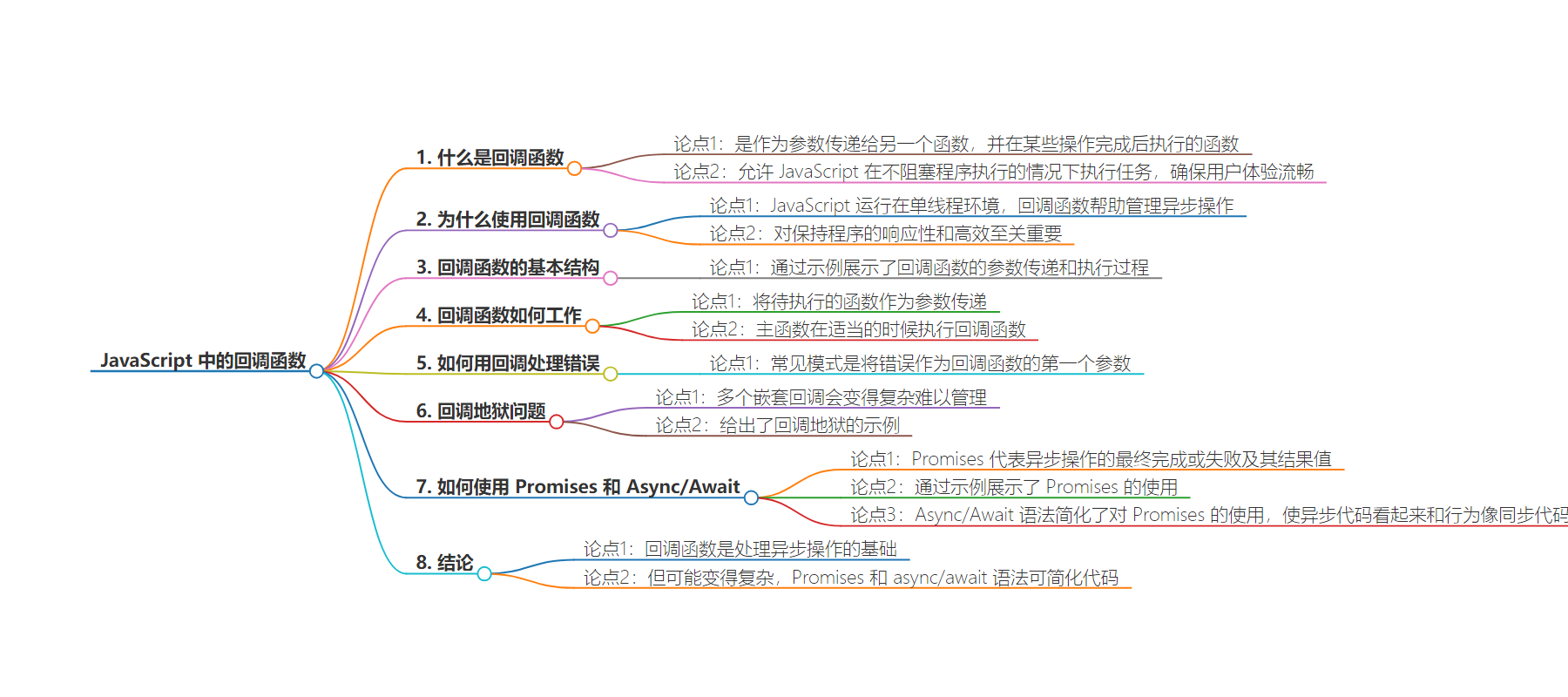包阅导读总结
1.
– `JavaScript`、`Callback Functions`、`Asynchronous Operations`、`Promises`、`Async/Await`
2.
本文主要介绍了 JavaScript 中的回调函数,包括其定义、用途、基本结构、工作原理、错误处理,还提到了回调地狱问题及解决方案,如 Promises 和 async/await 语法,强调理解这些有助于编写更高效和可维护的代码。
3.
– Callback Functions in JavaScript
– What is a Callback Function: 作为参数传递给另一函数,在某些操作完成后执行
– Why Use Callback Functions: 处理异步操作,确保代码流畅运行
– Basic Structure: 通过示例展示其基本结构
– How Callbacks Work: 函数传递与回调执行的过程
– How to Handle Errors with Callbacks: 处理错误的常见模式
– The Callback Hell Problem: 多个嵌套回调导致的复杂和难以管理问题
– How to Use Promises and Async/Await: 介绍 Promises 和 async/await 语法简化异步代码
– Conclusion: 回调函数重要但可能复杂,新语法可简化代码
思维导图:
文章地址:https://www.freecodecamp.org/news/how-to-use-callback-functions-in-javascript/
文章来源:freecodecamp.org
作者:Oluwadamisi Samuel
发布时间:2024/9/9 16:09
语言:英文
总字数:786字
预计阅读时间:4分钟
评分:87分
标签:JavaScript,回调函数
以下为原文内容
本内容来源于用户推荐转载,旨在分享知识与观点,如有侵权请联系删除 联系邮箱 media@ilingban.com
When you’re building dynamic applications with JavaScript that display real-time data – like a weather app or live sports dashboard – you’ll need a way to automatically fetch new data from an external source without disrupting the user experience.
You can do this using JavaScript’s callback functions, which showcase JavaScript’s ability to handle asynchronous operations. Let’s explore what callback functions are, how they work, and why they’re essential in JavaScript.
Table of Contents
What is a Callback Function?
A callback function is a function that is passed as an argument to another function and is executed after the completion of some operations.
This mechanism allows JavaScript to perform tasks like reading files, making HTTP requests, or waiting for user input without blocking the execution of the program. This helps ensure a smooth user experience.
Why Use Callback Functions?
JavaScript runs in a single-threaded environment, meaning it can only execute one command at a time. Callback functions help manage asynchronous operations, ensuring that the code continues to run smoothly without waiting for tasks to complete. This approach is crucial for maintaining a responsive and efficient program.
Basic Structure of a Callback Function
To illustrate, let’s look at a simple example:
function greet(name, callback) { console.log(`Hello, ${name}!`); callback();}function sayGoodbye() { console.log("Goodbye!");}greet("Alice", sayGoodbye);In this code:
-
greetis a function that takes a name and a callback function as arguments. -
After greeting the user, it calls the callback function.
How Callbacks Work
-
Passing the Function: The function you want to run after some operation is passed as an argument to another function.
-
Executing the Callback: The main function executes the callback function at the appropriate time. This can be after a delay, once a task is complete, or when an event occurs.
Here’s a more detailed example with a simulated asynchronous operation using setTimeout:
function fetchData(callback) { setTimeout(() => { const data = { id: 1, name: "Alice" }; callback(data); }, 2000); }fetchData((data) => { console.log("Data received:", data);});In this example:
How to Handle Errors with Callbacks
In real-world scenarios, you’ll often need to handle errors. A common pattern is to pass an error as the first argument to the callback function:
function readFile(filePath, callback) { const fs = require('fs'); fs.readFile(filePath, 'utf8', (err, data) => { if (err) { callback(err, null); } else { callback(null, data); } });}readFile('example.txt', (err, data) => { if (err) { console.error("Error reading file:", err); } else { console.log("File content:", data); }});Here:
The Callback Hell Problem
As applications grow, using multiple nested callbacks can become complex and hard to manage, often referred to as “callback hell.” Here’s an example of callback hell:
function stepOne(callback) { setTimeout(() => callback(null, 'Step One Completed'), 1000);}function stepTwo(callback) { setTimeout(() => callback(null, 'Step Two Completed'), 1000);}function stepThree(callback) { setTimeout(() => callback(null, 'Step Three Completed'), 1000);}stepOne((err, result) => { if (err) return console.error(err); console.log(result); stepTwo((err, result) => { if (err) return console.error(err); console.log(result); stepThree((err, result) => { if (err) return console.error(err); console.log(result); }); });});This code is difficult to read and maintain. To solve this, modern JavaScript provides Promises and async/await syntax, making code cleaner and easier to handle.
How to Use Promises and Async/Await
Promises represent the eventual completion (or failure) of an asynchronous operation and its resulting value.
function fetchData() { return new Promise((resolve, reject) => { setTimeout(() => { resolve({ id: 1, name: "Alice" }); }, 2000); });}fetchData() .then(data => { console.log("Data received:", data); }) .catch(error => { console.error("Error:", error); });Async/Await syntax simplifies working with Promises:
async function getData() { try { const data = await fetchData(); console.log("Data received:", data); } catch (error) { console.error("Error:", error); }}getData();This approach makes asynchronous code look and behave like synchronous code, improving readability and maintainability.
You can read more about promises and async/await here.
Conclusion
Callback functions are fundamental in JavaScript for handling asynchronous operations. While they offer a powerful way to manage asynchronous flow, they can become complex and hard to maintain.
Using Promises and async/await syntax can simplify your code, making it cleaner and easier to manage.
Understanding these concepts will help you write more efficient and maintainable JavaScript code.
Connect with me on LinkedIn and Twitter if you found this helpful.
